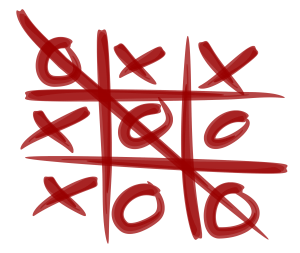Everyone knows the game of Tic-Tac-Toe. It is a game that you learned as a kid and one that you still play when you are on a plane, have some time to kill or (let’s be honest) are bored in class. Well did you ever think that such a simple game could be used in VT? I never did.
As I am going through my externship, what I am finding is that this is the beauty of vision therapy: an ordinary, everyday thing can be used as a training technique. With a few modifications Tic-Tac-Toe can be used in various ways to touch upon different types of weaknesses seen in children with perceptual difficulties.
 The ideas are limitless, but here are few:
The ideas are limitless, but here are few:
- Visual Planning: This is the way you normally play the game. The child must look at the board, strategize and then make a decision of where to go.
- Visual Spatial Memory: There are two ways you can do this:
1) Have one board set up and after each turn, cover up the board with your hand and ask the child where they want to go verbally.
2) Set up two boards side by side (one for you and one for the child). Once you take your turn, cover your board and have the child place only his/her symbols on their board. This requires them to both remember where you placed your symbol and visualize it on their board. **Gauge the child’s ability: make it easier by not covering your board. The child still has to compare the two boards and visualize the space from your board to theirs. When they are ready, try covering the board again.**
- Directionality: To help kids with L & R issues re-label the board; that is give each box a new name based on its location, i.e. the top left box is ‘upper left’ and the lower right box is ‘lower right.’ Instead of the child having to draw in where they want to go they must first say out loud the box they want to use. If they make a directionality error by saying to put their symbol in a box that is already filled, they lose their turn.
**Gauge the child’s ability: start out with the board fully labeled and play one round. If they are successful with no mistakes, remove the labels and play again.**
- Letter Reversals: Kids with directionality issues often struggle with letter reversals as well. So, who said that you have to use “X’s” and “O’s” as your symbols?! Use letters like “p” & “q”, “b” & “d”, “2” and “5”, “9” and “6” for kids that reverse and invert letters and numbers. This is a fun way to teach them the difference between them.
Like I said earlier, the ideas are endless. Not only can you use it as a perceptual activity, but you can incorporate it as a near/far activity or even an MFBF activity for your amblyopes! Vision therapy should be designed to work on the child’s weakness, finding a balance between having them be successful and keeping them challenged at the same time. If you can have fun while doing that- it is more rewarding for both YOU and the child.
Enjoy!
-Mikilyn

